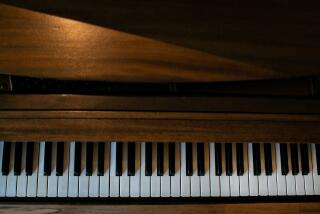SEGOVIA AT 93: ‘ART RENEWS THE SPIRIT’
NEW YORK — The odds are that no modern classical instrumentalist has had more of a revolutionary impact on his art than Andres Segovia, who begins teaching a master class today at USC at the ripe age of 93.
It’s hard to think where the classical guitar would be right now without Segovia. He was never the most technically precise of players, and although he prides himself on having commissioned a number of works from composers who otherwise hadn’t considered writing for the guitar, he seems most at rest in the garden of the classical tradition.
To see him play is almost as affecting as it is to hear him. It’s a bit startling to witness, in our mechanized, multifarious, noisy, depersonalized age, a solitary man walk on to a stage and proceed to spellbind us with a simple-looking--albeit elegant--instrument consisting of six strings stretched over a long neck and a shapely wooden hollow.
Watching him play is like happening into a moonlit bedroom and discovering someone praying, or doting on his sleeping child. He has that look of someone enraptured, and it comes through in his music, through which he creates the illusion of total intimacy with the palpable complications and feelings of an artist in dreamlike flight.
“It is the most beautiful, poetical instrument ever devised by man,” he said. “Being polyphonic, it has different, complicated factors. Everything is possible with a guitar.”
In his thick Castilian accent he added, “I am glad there is a boom for the guitar in all the world. In Japan, there are 4 million students of both sexes. The guitar is played everywhere in the United States, Europe and South America. Now, it’s ahead of the violin and the cello, and the piano.”
He’s noncommittal over the suggestion that those millions of tributaries may well spring from a single source--Andres Segovia. He measures his success less in numbers than in the knowledge that “from the beginning I tried to rescue the guitar from the folklore, where she was captured. There were great guitarists before me, such as Giuliani, and Sor--Sor was a magnificent composer, not only for the guitar, but for the orchestra and the ballet.
“I try not to be the interpreter of compositions made just by guitarists. That’s a narrow world. I have asked many symphonic composers to write for the guitar. At first they refuse. ‘I don’t know how,’ they say. But then they learn. Castelnuovo-Tedesco, for example, came late to the guitar and wrote more than 100 compositions. They are captivated by the guitar. It has poetry, and always a little melancholy.”
Segovia raised a hand, index finger close to thumb, to describe how little the melancholy is. His hands are surprisingly big and blunt, with thick, sausage-like fingers--not the nervous, spidery digits you might expect of an aesthete. But it seems he’s always been a somewhat unlikely figure, someone so in love with the music of the ages that he willed himself into premature age to conceal a perpetual youthfulness within. (Twice married, he fathered his last child at the age of 78.)
He was never physically imperious, never a patrician, like Vladimir Horowitz. Somehow his pot, his wispy white fringe of hair, and--especially of late--the wader’s legs that move like afterthoughts worked against a lofty image. In his younger photos he looked like a stuffy academic, viewing the world through round-rimmed eyeglasses. In his older pictures he resembles a kindly old tinkerer who nightly reaches for the body of a woman (he frequently alludes to the guitar as being female) and touches revelations, secrets of the universe.
Segovia is not without humor. “I like Los Angeles,” he said--he last gave a master class at USC in 1981, though he concertizes here annually. “They gave me the key to the city.”
“Once, in Cincinnati, the mayor came between the third and fourth part of a performance to give me the key to the city. It was a tiny key. I said, ‘With a little key like this, I don’t think I can enter the door to the city. It must be a very little door.’ ”
But today, on a humid, sullen New York afternoon, he was philosophical. Of the upcoming class (which can be audited by as many students as will fit into Bovard Auditorium), he said, “I listen to only 12 students that I want to teach. No more. It’s important to distribute time for people.
“Music is like the ocean--the instrument is like a little island on it. All I ask is that they study properly and profoundly. Otherwise they are not real artists. Even still, it’s a small centimeter that makes art.”
It would not be an overstatement to say that art is sacred to Segovia, who began his guitar studies at the age of 7 and, after a difficult beginning (that is, with a nasty instructor), took it up in earnest when his family moved to Granada.
“I am very old to change my feelings for the truth of art. Today everybody’s a composer, a painter, a poet, and it’s absurd. You see a little fern spiraling up and someone calls it sculpture. Compare that to Michelangelo, Donatello, Rodin. I admire music from the beginning to Bach, Debussy, Stravinsky. Beyond that, it’s difficult to find music that’s artistic. I take great pleasure in practicing and playing, but I also like philosophy, history, literature, in order to be whole and not a part. I had 7,000 volumes in my library in Madrid before it was destroyed in the civil war. I have that many volumes in my houses now again.
“I admire Bergson for his extraordinary clarity of mind. In Spain, I love Unamuno. I am with them, not with the false things. I am religious, a believer, but it’s a complicated thing. When I read of a building on fire, where children burn to death, it is something I don’t understand.
“I had a historian-philosopher friend who used to say that our Lord has an immense universe to deal with, and for the Earth he’s appointed a vice-God who is sometimes distracted. I don’t believe that, but in synthesis, the evil of this world, the intellectual, moral and physical suffering--I don’t understand that.”
Segovia is older than the 20th Century, of which he says, “Technology has created marvels--to go to the moon, the discovery of things for the health. But for the moral rectitude and behavior of people? No. We’ll have to wait for the next century. I am very sad at everything that has happened on account of the politicians. Look at the Soviets! They have a dictatorship that is the most cruel, yet they criticize the life you have in the United States, where everybody is free to choose his own road in life.”
Still, Segovia has remained largely free of pessimism and despair.
“My life has been a steady ascending line, without falling or going back. The only great pain I’ve ever had was when my son and daughter died.” (When at school in Switzerland, his son was accidentally electrocuted; his grown daughter died in Guatemala from a toxic reaction to antibiotics. Segovia has a surviving 64-year-old son, who’s a painter in Paris, and his 15-year-old, who joins him at USC.)
“To this day, I have a little light inside me for both of them. Their deaths are mysterious, impossible for me to understand. There’s a little boy in legend who lived for three hours and said, ‘For so little time, why to me?’ I still ask myself, ‘Where are they?’
“That’s my only sadness. Music and art are my life. My health is good. Time is short. The phenomenon of life is to be born without the conception of what it is to be born, to live, decay, and perish. I’ve talked with great men, seen beautiful women, and have always had the same friends. I’ve never in my life quarreled with a good friend. The gift of beauty is eternal. Art renews the spirit. If you get tired of reading the same poem, or seeing the same painting, the fault isn’t in the art. It’s in yourself, when you fail to vibrate to beauty.”
The afternoon grew late as the conversation wound down. On the glass table before him lay a bowl of fruit, one form of nourishment. In its case, on another table to his right, lay his guitar, as if waiting.
More to Read
The biggest entertainment stories
Get our big stories about Hollywood, film, television, music, arts, culture and more right in your inbox as soon as they publish.
You may occasionally receive promotional content from the Los Angeles Times.










